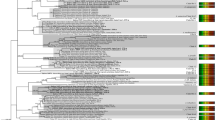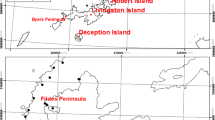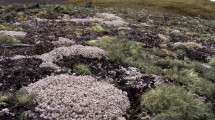Abstract
Lichens are present in most terrestrial ecosystems on Earth and colonize extreme habitats, where vascular plants are unable to thrive, due to unique properties of the fungal-algal symbiosis. Here, we explored the phylogeographic structure of green algae engaged in symbiosis with species in the genus Pseudephebe (Parmeliaceae). These often form deep brown to blackish fruticose thalli on acidic rocks, and have partially overlapping distributions: P. minuscula is bipolar and co-occurs with P. pubescens in Europe. Based on a broad sampling, including the Arctic and Antarctica, we focused on photobionts (1) to identify genetic lineages and their phylogenetic assignment, (2) to infer the haplotype distribution in relation with geography and the mycobiont’s identity, and (3) to evaluate spatial genetic structure and polymorphism. Results revealed three Trebouxia clade S lineages (Trebouxia S02, T. suecica and T. angustilobata) associated to Pseudephebe species, with predominant haplotypes distributed throughout the entire geographic distribution, and some, less frequent, shared between widely distant localities. Photobiont switching was evident in the Mediterranean region, and algal co-occurrence was frequent in both mycobionts, which shared the same set of photobionts; this could explain, at least partially, their overlapping distribution. Furthermore, genetic structure was influenced by geography given the substantial percentages of genetic variation (ca. 25–50%) explained by the different delimited eco−/biogeographic regions. In Continental Antarctica, mycobionts showed a high specialization towards the photobionts, which are probably endemic of this climatically extreme region. Taken together, our findings provide further insight about the processes shaping lichen biogeography.




Similar content being viewed by others
Data availability
The datasets generated during and/or analyzed during the current study are available in GenBank (DNA sequences) and FigShare (alignments, https://doi.org/10.6084/m9.figshare.12587645), and the Pseudephebe thalli are kept in the following herbaria: the Royal Botanical Garden of Madrid (MA), University of Graz-Institute of Plant Sciences (GZU), Michigan State University (MSC), Herbario Nacional de Bolivia (LPB), University Complutense of Madrid-Faculty of Pharmacy (MAF), and University of Copenhagen (C).
References
Altschul SF, Madden TL, Schäffer AA, Zhang J, Zhang Z, Miller W, Lipman DJ (1997) Gapped BLAST and PSI-BLAST: a new generation of protein database search programs. Nucleic Acids Res 25:3389–3402
Álvarez R, del Hoyo A, Díaz-Rodríguez C, Coello AJ, del Campo EM, Barreno E, Catalá M, Casano LM (2015) Lichen rehydration in heavy metal-polluted environments: Pb modulates the oxidative response of both Ramalina farinacea thalli and its isolated microalgae. Microb Ecol 69:698–709
Bačkor M, Peksa O, Škaloud P, Bačkorová M (2010) Photobiont diversity in lichens from metal-rich substrata based on ITS rDNA sequences. Ecotoxicol Environ Saf 73(4):603–612
Barreno E, Pérez-Ortega S (2003) Líquenes de la Reserva Natural Integral de Muniellos, Asturias. Ed KRK, Oviedo
Beck A, Friedl T, Rambold G (1998) Selectivity of photobiont choice in a defined lichen community: inferences from cultural and molecular studies. New Phytol 139:709–720
Blaha J, Baloch E, Grube M (2006) High photobiont diversity associated with the euryoecious lichen-forming ascomycete Lecanora rupicola (Lecanoraceae, Ascomycota). Biol J Linn Soc 88:283–293
Blüthgen N, Menzel F, Blüthgen N (2006) Measuring specialization in species interaction networks. BMC Ecol 6:9
Boluda CG, Hawksworth DL, Divakar PK, Crespo A, Rico VJ (2016) Microchemical and molecular investigations reveal Pseudephebe species as cryptic with an environmentally modified morphology. Lichenologist 48(5):527–543
Brodo IM, Sharnoff SD, Sharnoff S, Canadian Museum of Nature (2001) Lichens of North America. Yale University Press, New Haven
Buschbom J, Mueller GM (2006) Testing “species pair” hypotheses: evolutionary processes in the lichen-forming species complex Porpidia flavocoerulescens and Porpidia melinodes. Mol Biol Evol 23(3):574–586
Casano LM, del Campo EM, García-Breijo FJ, Reig-Armiñana J, Gasulla F, Del Hoyo A, Barreno E (2011) Two Trebouxia algae with different physiological performances are ever-present in lichen thalli of Ramalina farinacea. Coexistence versus competition? Environ Microbiol 13:806–818
Castello M, Nimis PL (1997) Diversity of lichens in Antarctica. In: Battaglia B, Valencia J, Walton DWH (eds) Antarctic communities: species, structure and survival. Cambridge University Press, Cambridge, pp 15–21
Català S, Del Campo EM, Barreno E, García-Breijo FJ, Reig-Armiñana J, Casano LM (2016) Coordinated ultrastructural and phylogenomic analyses shed light on the hidden phycobiont diversity of Trebouxia microalgae in Ramalina fraxinea. Mol Phylogenet Evol 94:765–777
Chen JM, Werth S, Sork VL (2016) Comparison of phylogeographical structures of a lichen-forming fungus and its green algal photobiont in western North America. J Biogeogr 43(5):932–943
Dal Grande F, Rolshausen G, Divakar PK, Crespo A, Otte J, Schleuning M, Schmitt I (2018) Environment and host identity structure communities of green algal symbionts in lichens. New Phytol 217(1):277–289
De los Ríos A, Ascaso C (2002) Preparative techniques for transmission electron microscopy and confocal laser scanning microscopy of lichens. In: Kranner I, Beckett RP, Varma AK (eds) Protocols in lichenology. Springer-Verlag, Berlin, Heidelberg, pp 87–117
Del Campo EM, Casano LM, Barreno E (2013) Evolutionary implications of intron-exon distribution and the properties and sequences of the RPL10A gene in eukaryotes. Mol Phylogenet Evol 66:857–867
Devkota S, Chaudhary RP, Werth S, Scheidegger C (2019) Genetic diversity and structure of the epiphytic foliose lichen Lobaria pindarensis in the Himalayas depends on elevation. Fun Eco 41:245–255
Domaschke S, Fernández-Mendoza F, García MA, Martín M, Printzen C (2012) Low genetic diversity in Antarctic populations of the lichen-forming ascomycete Cetraria aculeata and its photobiont. Polar Res 31:17353
Dormann CF, Gruber B, Fründ J (2008) Introducing the bipartite package: analysing ecological networks. Interaction 1:0.2413793
Drenth A, McTaggart AR, Wingfield BD (2019) Fungal clones win the battle, but recombination wins the war. IMA Fungus 10:18
Du Rietz E (1940) Problems of bipolar plant distribution. Acta Phytogeogr Suec 13:215–282
Excoffier L, Lischer HEL (2010) Arlequin suite ver. 3.5: a new series of programs to perform population genetics analyses under Linux and windows. Mol Ecol Resour 10:564–567
Fedrowitz K, Kaasalainen U, Rikkinen J (2012) Geographic mosaic of symbiont selectivity in a genus of epiphytic cyanolichens. Ecol Evol 2:2291–2303
Fernández-Mendoza F, Printzen C (2013) Pleistocene expansion of the bipolar lichen Cetraria aculeata into the southern hemisphere. Mol Ecol 22:1961–1983
Fernández-Mendoza F, Domaschke S, García MA, Jordan P, Martín MP, Printzen C (2011) Population structure of mycobionts and photobionts of the widespread lichen Cetraria aculeata. Mol Ecol 20:1208–1232
Friedl T (1989) Comparative ultrastructure of pyrenoids in Trebouxia (Microthamniales, Chlorophyta). Plant Syst Evol 164:145–159
Garrido-Benavent I, Pérez-Ortega S (2017) Past, present, and future research in bipolar lichen-forming fungi and their photobionts. Am J Bot 104(11):1660–1674
Garrido-Benavent I, Pérez-Ortega S, de los Ríos A (2017) From Alaska to Antarctica: species boundaries and genetic diversity of Prasiola (Trebouxiophyceae), a foliose chlorophyte associated with the bipolar lichen-forming fungus Mastodia tessellata. Mol Phylogenet Evol 107:117–131
Garrido-Benavent I, de los Ríos A, Fernández-Mendoza F, Pérez-Ortega S (2018) No need for stepping stones: direct, joint dispersal of the lichen-forming fungus Mastodia tessellata (Ascomycota) and its photobiont explains their bipolar distribution. J Biogeogr 45:213–224
Gasulla F, Guéra A, de los Ríos A, Pérez-Ortega S (2019) Differential responses to salt concentrations of lichen photobiont strains isolated from lichens occurring in different littoral zones. Plant Fungal Syst 64(2):149–162
Gilbert OL, Purvis OW (2009) Pseudephebe. In: Smith CW, Aptroot A, Coppins BJ, Fletcher A, Gilbert OL, James PW, Wolseley PA (eds) The lichens of Great Britain and Ireland. British Lichen Society, London, p 758
Hestmark G, Lutzoni F, Miadlikowska J (2016) Photobiont associations in co-occurring umbilicate lichens with contrasting modes of reproduction in coastal Norway. Lichenologist 48(5):545–557
Joly S, Stevens MI, van Vuuren BJ (2007) Haplotype networks can be misleading in the presence of missing data. Syst Biol 56:857–862
Jukes T, Cantor C (1969) Evolution of protein molecules. In: Munro M (ed) Mammalian protein metabolism. Academic Press, New York, pp 21–132
Katoh K, Misawa K, Kuma KI, Miyata T (2002) MAFFT: a novel method for rapid multiple sequence alignment based on fast Fourier transform. Nucl Acids Res 30:3059–3066
Kroken S, Taylor JW (2000) Phylogenetic species, reproductive mode, and specificity of the green alga Trebouxia forming lichens with the fungal genus Letharia. Bryologist 103:645–660
Lamb IM (1948) Antarctic pyrenocarp lichens. Discov Rep 25:1–30
Lamb IM (1970) Antarctic terrestrial plants and their ecology. In: Holdgate MW (ed) Antarctic ecology, 2nd edn. Academic Press, London, pp 733–751
Leavitt SD, Kraichak E, Nelsen MP, Altermann S, Divakar PK, Alors D, Esslinger TL, Crespo A, Lumbsch T (2015) Fungal specificity and selectivity for algae play a major role in determining lichen partnerships across diverse ecogeographic regions in the lichen-forming family Parmeliaceae (Ascomycota). Mol Ecol 24:3779–3797
Leavitt SD, Kraichak E, Vondrak J, Nelsen MP, Sohrabi M, Pérez-Ortega S, St Clair LL, Lumbsch HT (2016) Cryptic diversity and symbiont interactions in rock-posy lichens. Mol Phylogenet Evol 99:261–274
Leigh JW, Bryant D (2015) POPART: full-feature software for haplotype network construction. Methods Ecol Evol 6:1110–1116
Letunic I, Bork P (2019) Interactive tree of life (iTOL) v4: recent updates and new developments. Nucleic Acids Res 47:W256–W259
Librado P, Rozas J (2009) DnaSP v. 5: a software for comprehensive analysis of DNA polymorphism data. Bioinformatics 25:1451–1452
Lindblom L, Søchting U (2013) Genetic diversity of the photobiont of the bipolar lichen-forming ascomycete Xanthomendoza borealis. Herzogia 26:307–322
Miller MA, Pfeiffer W, Schwartz T (2010) Creating the CIPRES science gateway for inference of large phylogenetic trees. In: Proceedings of the gateway computing environments workshop (GCE), pp 1–8 New Orleans
Molins A, Moya P, García-Breijo FJ, Reig-Armiñana J, Barreno E (2018) Molecular and morphological diversity of Trebouxia microalgae in sphaerothallioid Circinaria spp. lichens. J Phycol 54(4):494–504
Muggia L, Pérez-Ortega S, Kopun T, Zellnig G, Grube M (2014) Photobiont selectivity leads to ecological tolerance and evolutionary divergence in a polymorphic complex of lichenized fungi. Ann Bot 114:463–475
Muggia L, Nelsen MP, Kirika PM, Barreno E, Beck A, Lindgren H, Lumbsch HT, Leavitt SD, Trebouxia working group. (2020) Formally described species woefully underrepresent phylogenetic diversity in the common lichen photobiont genus Trebouxia (Trebouxiophyceae, Chlorophyta): an impetus for developing an integrated taxonomy. Mol Phylogenet Evol 106821 https://doi.org/10.1016/j.ympev.2020.106821
Nadyeina O, Dymytrova L, Naumovych A, Postoyalkin S, Werth S, Cheenacharoen S, Scheidegger C (2014) Microclimatic differentiation of gene pools in the Lobaria pulmonaria symbiosis in a primeval forest landscape. Mol Ecol 23:5164–5178
Nelsen MP, Gargas A (2008) Dissociation and horizontal transmission of codispersing lichen symbionts in the genus Lepraria (Lecanorales: Stereocaulaceae). New Phytol 177:264–275
Nelsen MP, Gargas A (2009) Symbiont flexibility in Thamnolia vermicularis (Pertusariales: Icmadophilaceae). Bryologist 112(2):404–417
Nelsen MP, Lücking R, Boyce CK, Lumbsch HT, Ree RH (2020) No support for the emergence of lichens prior to the evolution of vascular plants. Geobiology 18(1):3–13
Ohmura Y, Kawachi M, Kasai F, Watanabe MM, Takeshita S (2006) Genetic combinations of symbionts in a vegetatively reproducing lichen, Parmotrema tinctorum, based on ITS rDNA sequences. Bryologist 109:43–59
Ohmura Y, Takeshita S, Kawachi M (2019) Photobiont diversity within populations of a vegetatively reproducing lichen, Parmotrema tinctorum, can be generated by photobiont switching. Symbiosis 77:59–72
Onuţ-Brännström I, Tibell L, Johannesson H (2017) A worldwide phylogeography of the whiteworm lichens Thamnolia reveals three lineages with distinct habitats and evolutionary histories. Ecol Evo 7:3602–3615
Onuț-Brännström I, Benjamin M, Scofield DG, Heiðmarsson S, Andersson MG, Lindström ES, Johannesson H (2018) Sharing of photobionts in sympatric populations of Thamnolia and Cetraria lichens: evidence from high-throughput sequencing. Sci Rep 8(1):1–14
Opanowicz M, Grube M (2004) Photobiont genetic variation in Flavocetraria nivalis from Poland (Parmeliaceae, lichenized Ascomycota). Lichenologist 36(2):125–131
Ordynets A, Heilmann-Clausen J, Savchenko A, Bässler C, Volobuev S, Akulov O, Karadelev M, Kotiranta H, Saitta A, Langer E, Abrego N (2018) Do plant-based biogeographical regions shape aphyllophoroid fungal communities in Europe? J Biogeogr 45(5):1182–1195
Ortiz-Álvarez R, de los Ríos A, Fernández-Mendoza F, Torralba-Burrial A, Pérez-Ortega S (2015) Ecological specialization of two photobiont-specific maritime cyanolichen species of the genus Lichina. PLoS One 10:e0132718
Ossowska E, Guzow-Krzemińska B, Kolanowska M, Szczepańska K, Kukwa M (2019) Morphology and secondary chemistry in species recognition of Parmelia omphalodes group–evidence from molecular data with notes on the ecological niche modelling and genetic variability of photobionts. MycoKeys 61:39–74
Peat HJ, Clarke A, Convey P (2007) Diversity and biogeography of the Antarctic flora. J Biogeogr 34(1):132–146
Peksa O, Škaloud P (2011) Do photobionts influence the ecology of lichens? A case study of environmental preferences in symbiotic green alga Asterochloris (Trebouxiophyceae). Mol Ecol 20:3936–3948
Pérez-Ortega S, Miller KA, de los Ríos A (2018) Challenging the lichen concept: Turgidosculum ulvae (Verrucariaceae) represents an independent photobiont shift to a multicellular blade-like alga. Lichenologist 50(3):341–356
Piercey-Normore MD, DePriest PT (2001) Algal switching among lichen symbioses. Am J Bot 88:1490–1498
Reynolds ES (1963) The use of lead citrate at high pH as an electron-opaque stain in electron microscopy. J Cell Biol 17(1):208–212
Rikkinen J, Oksanen I, Lohtander K (2002) Lichen guilds share related cyanobacterial symbionts. Science 297:357
Roca-Valiente B (2013) Estudio filogenético del grupo de “Rhizocarpon geographicum” (liquenes, Rhizocarpaceae, Ascomycota). Análisis contrastado de los caracteres morfológicos y los patrones biogeográficos. Universidad Complutense de Madrid, Madrid, Spain, Ph.D. dissertation
Rolshausen G, Dal Grande F, Sadowska-Deś AD, Otte J, Schmitt I (2018) Quantifying the climatic niche of symbiont partners in a lichen symbiosis indicates mutualist-mediated niche expansions. Ecography 41:1380–1392
Rolshausen G, Hallman U, Grande FD, Otte J, Knudsen K, Schmitt I (2020) Expanding the mutualistic niche: parallel symbiont turnover along climatic gradients. P Roy Soc B-Biol SCI 287(1924):20192311
Romeike J, Friedl T, Helms G, Ott S (2002) Genetic diversity of algal and fungal partners in four species of Umbilicaria (lichenized Ascomycetes) along a transect of the Antarctic peninsula. Mol Biol Evol 19:1209–1217
Ruprecht U, Brunauer G, Printzen C (2012) Genetic diversity of photobionts in Antarctic lecideoid lichens from an ecological view point. Lichenologist 44:661–678
Sela I, Ashkenazy H, Katoh K, Pupko T (2015) GUIDANCE2: accurate detection of unreliable alignment regions accounting for the uncertainty of multiple parameters. Nucleic Acids Res 43:W7–W14
Seppelt RD (1995) Phytogeography of continental Antarctic lichens. Lichenologist 27:417–431
Singh G, Dal Grande F, Divakar PK, Otte J, Crespo A, Schmitt I (2017) Fungal-algal association patterns in lichen symbiosis linked to macroclimate. New Phytol 214:317–329
Sork VL, Werth S (2014) Phylogeography of Ramalina menziesii, a widely distributed lichen-forming fungus in western North America. Mol Ecol 23(9):2326–2339
Stamatakis A (2006) RAxML-VI-HPC: maximum likelihood-based phylogenetic analyses with thousands of taxa and mixed models. Bioinformatics 22:2688–2690
Stamatakis A, Hoover P, Rougemont J (2008) A rapid bootstrap algorithm for the RAxML web servers. Syst Biol 57:758–771
Steinová J, Škaloud P, Yahr R, Bestová H, Muggia L (2019) Reproductive and dispersal strategies shape the diversity of mycobiont-photobiont association in Cladonia lichens. Mol Phylogenet Evol 134:226–237
Stenroos S, Velmala S, Pykälä J, Ahti T (2016) Lichens of Finland. Norrlinia 30:1–896
Templeton AR, Crandall KA, Sing CF (1992) A cladistic analysis of phenotypic association with haplotypes inferred from restriction endonuclease mapping and DNA sequence data. III Cladogram estimation Genetics 132:619–635
Thüs H, Muggia L, Pérez-Ortega S, Favero-Longo SE, Joneson S, O’Brien H, Nelsen MP, Duque-Thüs R, Grube M, Friedl T, Brodie J, Andrew CJ, Lücking R, Lutzoni F, Gueidan C (2011) Revisiting photobiont diversity in the lichen family Verrucariaceae (Ascomycota). Eur J Phycol 46(4):399–415
Vančurová L, Muggia L, Peksa O, Řídká T, Škaloud P (2018) The complexity of symbiotic interactions influences the ecological amplitude of the host: a case study in Stereocaulon (lichenized Ascomycota). Mol Ecol 27(14):3016–3033
Vargas Castillo R, Beck A (2012) Photobiont selectivity and specificity in Caloplaca species in a fog-induced community in the Atacama Desert, northern Chile. Fungal Biol 116:665–676
Werth S, Scheidegger C (2012) Congruent genetic structure in the lichen-forming fungus Lobaria pulmonaria and its green-algal photobiont. Mol Plant-Microbe Interact 25:220–230
Werth S, Sork VL (2014) Ecological specialization in Trebouxia (Trebouxiophyceae) photobionts of Ramalina menziesii (Ramalinaceae) across six range-covering ecoregions of western North America. Am J Bot 101:1127–1140
Woods AJ, Omernik JM, Pederson CL, Moran BC (2006) Level III and IV ecoregions of Illinois. EPA/600/R-06/104. USEPA National Health and environmental effects research lab., Corvallis, OR
Wornik S, Grube M (2010) Joint dispersal does not imply maintenance of partnerships in lichen symbioses. Microb Ecol 59(1):150–157
Yahr R, Vilgalys R, DePriest PT (2006) Geographic variation in algal partners of Cladonia subtenuis (Cladoniaceae) highlights the dynamic nature of a lichen symbiosis. New Phytol 171:847–860
Acknowledgements
The authors would like to thank the Marine Technology Unit (UTM) of CSIC, and the Antarctica New Zealand agency for providing the necessary logistics for field work in Antarctica. We also thank Adam Flakus (Krakow, PL), Ana Millanes, Leopoldo G. Sancho and José Raggio (Madrid, ES), Antonio Gómez-Bolea and Esteve Llop (Barcelona, ES), Toby Spribille (Edmonton, CA), Ulrik Søchting (Copenhagen, DK) and Göran Thor (Uppsala, SE) for contributing to collections; Beatriz Martín Jouve (CNB, Madrid, ES) for her technical support in electron microscopy observation; Theodora Kopun (KFU Graz, AU) for her advice and help in the laboratory; and Helmut Mayrhofer and Martin Grube (KFU Graz, AU) for institutional support.
Funding
This study was financed by the Austrian FWF Einzelprojekt P26359 and partially by CTM2015–64728- C2–2-R (MINECO/FEDER, UE). IGB was supported by grant FPU AP2012–3556 (MECD) and “Estancia Breve-FPU” (no. EST14/00481, MECD), and SPO by RYC-2014-16,784 (MINECO).
Author information
Authors and Affiliations
Contributions
All authors contributed to the study conception and design. Material preparation, data collection and analyses were performed by Isaac Garrido-Benavent, Sergio Pérez-Ortega, Asunción de los Ríos and Fernando Fernández-Mendoza. The first draft of the manuscript was written by Isaac Garrido-Benavent and all authors commented on previous versions of the manuscript. All authors read and approved the final manuscript.
Corresponding author
Ethics declarations
Conflicts of interest/competing interests
Not applicable.
Ethics approval
Not applicable.
Consent to participate
Not applicable.
Consent for publication
Not applicable
Additional information
Publisher’s note
Springer Nature remains neutral with regard to jurisdictional claims in published maps and institutional affiliations.
Rights and permissions
About this article
Cite this article
Garrido-Benavent, I., Pérez-Ortega, S., de los Ríos, A. et al. Amphitropical variation of the algal partners of Pseudephebe (Parmeliaceae, lichenized fungi). Symbiosis 82, 35–48 (2020). https://doi.org/10.1007/s13199-020-00709-5
Received:
Accepted:
Published:
Issue Date:
DOI: https://doi.org/10.1007/s13199-020-00709-5




